

Skywatcher, by Predrag Agatonovic.
Three planets – Jupiter, Mars and Saturn – pop out as darkness falls in June 2016. Jupiter, the brightest of the bunch, is found in the western half of the sky and lights up the night until midnight or later. Mars, only a touch fainter than Jupiter, shines above Saturn in the southeast sky at nightfall. Saturn comes closest to Earth for the year on June 3, less than four days after Mars’ closest approach to Earth on May 30. Mars and Saturn shine close to the supergiant red star Antares on the sky’s dome, painting a bright and colorful triangle on the blackboard of night. Not only are Mars and Saturn at their brightest and best in late May and early June, they’re out all night long. Mercury appears as a morning “star” before sunrise, though this morning showing of Mercury greatly favors the Southern Hemisphere. The brightest planet – Venus – is lost in the glare of sun in June. Follow the links below to learn more about the June planets.
Jupiter brightest “star” in June
Mars, dusk until dawn, shines near Saturn
Saturn, dusk until dawn, shines near Mars
Mercury in eastern predawn sky
Venus, brightest planet, lost in the sunrise
Like what EarthSky offers? Sign up for our free daily newsletter today!
Astronomy events, star parties, festivals, workshops

Three planets – Jupiter, Mars and Saturn – are bright in the evening sky throughout June 2016!

Use the moon to find planet Jupiter, star Regulus and constellation Leo on the evenings of June 9, June 10 and June 11. The green line depicts the ecliptic – the sun and moon’s pathway in front of the constellations of the zodiac.
Jupiter brightest “star” in June. Jupiter lights up the sky almost immediately after sunset on these June evenings. From mid-northern latitudes, the king planet shines in the southwest sky at nightfall. From the Southern Hemisphere, look in the northern sky as darkness falls.
For all of us, Jupiter sets in the west at or around midnight. It will remain a fine evening object throughout July and into August.
Jupiter is almost impossible to miss. It’s the fourth-brightest celestial object, after the sun, moon and Venus. But Venus is now lost in the glare of the sun, so Jupiter rules the nighttime on June evenings. Although Mars is not all that much fainter than Jupiter in early June, Jupiter and Mars are nowhere close together on the sky’s dome. As evening falls, Mars and Saturn sit rather low in the southeast sky, while Jupiter appears in the western half of sky. Most of all, Mars’ bloody-red color is dead giveaway of the red planet. Jupiter, on the other hand, shines bold white.
The moon swings close to Jupiter on the sky’s dome on June 10 and June 11.
If you have binoculars (on a tripod) or a telescope, it’s fairly easy to see Jupiter’s four major moons, which look like pinpricks of light on or near the same plane. They are often called the Galilean moons to honor Galileo, who discovered these great Jovian moons in 1610. In their order from Jupiter, these moons are Io, Europa, Ganymede and Callisto.

View larger. Jupiter and the Galilean moons through a 10″ (25 cm) Meade LX200 telescope via Jan Sandberg.
These moons circle Jupiter around the Jovian equator. In cycles of six years, we view Jupiter’s equator edge-on. So, in 2015, we got to view a number of mutual events involving Jupiter’s moons through a high-powered telescope. Click here or here or here for more details.
Although Jupiter’s axial tilt is only 3o out of perpendicular relative to the ecliptic (Earth’s orbital plane), Jupiter’s axis will tilt enough toward the sun and Earth so that the farthest of these four moons, Callisto, will not pass in front of Jupiter or behind Jupiter for a period of about three years, starting in late 2016.
During this approximate 3-year period, Callisto will remain perpetually visible, alternately swinging above and below Jupiter from our earthly perspective.
Click here for a Jupiter moons almanac, courtesy of Sky & Telescope.

View larger | Mikhail Chubarets in the Ukraine made this chart. It shows the view of Mars through a telescope in 2016. We pass between Mars and the sun on May 22. We won’t see Mars as a disk like this with the eye alone. But, between the start of 2016 and May, the dot of light that is Mars grows dramatically brighter and redder in our night sky. Watch for it!

Watch the brilliant waxing gibbous moon swing by the planets Mars and Saturn, plus the star Antares, on June 16, June 17 and June 18.
Mars, dusk until dawn, shines near Saturn. Mars is almost as bright as Jupiter when the month begins, but will fade quickly this month!
Mars was at its brightest at its opposition on May 22. Jupiter was at its brightest during its opposition on March 8. Mars and Jupiter will remain spectacularly bright in the June night sky, but, by the month’s end, you’ll notice the edge has gone off Mars’ brightness.
Looking for a sky almanac? EarthSky recommends…
Here’s some really good news, though. Mars is near another planet on the sky’s dome, Saturn. Look for Mars and Saturn near Antares, the brightest star in the constellation Scorpius the Scorpion. They make a noticeable triangle on the sky’s dome.
Let the moon help guide your eye to Mars (and the bright star Spica) for several evenings, centered on June 15. Then watch for the moon to swing away from Spica and more closely with Mars on June 16 and June 17. Then by June 18, the moon will move away from Mars to pair up with Saturn.

Yes, you can find the ringed Saturn near the brighter red planet Mars throughout June 2016! You can also find the bright star Spica between Jupiter and Mars. The green line depicts the ecliptic – pathway of the sun, moon and planets in front of the constellations of the zodiac. Read more.
Saturn, dusk until dawn, shines near Mars. Both Mars and Saturn are near a fainter object – still one of the sky’s brightest stars – Antares in the constellation Scorpius.
The ringed planet starts the month rising in the east around sunset. That’s because Saturn will be at opposition – opposite the sun in Earth’s sky – on June 3. At opposition, Saturn is rising in the east at sunset, and setting in the west at sunrise. At midnight, meanwhile, Saturn is highest up for the night. By the month’s end, Saturn will be coming up in the east roughly two hours before sunset, and will soar to its highest point for the night around 10 p.m. local time (11 p.m. local Daylight Saving Time).
Although Saturn shines on par with the sky’s brightest stars, its brilliance can’t match that of Mars. Look for Saturn near Mars all month long. These two worlds form a bright celestial triangle with the star Antares in the June night sky. Mars is brighter than Saturn, which in turn is brighter than Antares.
Mars will eventually catch up with Saturn on August 24, 2016, to present a conjunction of these two worlds in the August evening sky.
Watch for the moon to swing by Saturn for several days, centered on or near June 18.
Saturn, the farthest world that you can easily view with the eye alone, appears golden in color. It shines with a steady light. Binoculars don’t reveal Saturn’s gorgeous rings, by the way. For that, you need a small telescope. But binoculars will enhance Saturn’s golden color.
Saturn’s rings are inclined at a little more than 26o from edge-on in June 2016, exhibiting their northern face. Next year, in October 2017, the rings will open most widely, displaying a maximum inclination of 27o.
As with so much in space (and on Earth), the appearance of Saturn’s rings from Earth is cyclical. In the year 2025, the rings will appear edge-on as seen from Earth. After that, we’ll begin to see the south side of Saturn’s rings, to increase to a maximum inclination of 27o by May 2032.
Click here for recommended almanacs. They can help you know when the planets rise, transit and set in your sky

The slender waning crescent moon and Mercury, from the perspective of middle latitudes in the Northern Hemisphere. The Southern Hemisphere enjoys a much better view of Mercury in the morning sky because Mercury rises before morning dawn in that part of the world.
Mercury in eastern predawn sky. Mercury transitioned from the evening to morning sky on May 9, 2016. Usually, you can’t see Mercury at this juncture because it swings to the north or south of the solar disk, and is lost in the sun’s glare. But this time around, some of you actually witnessed the planet Mercury passing directly in front of the sun on June 3, less than four days after Mars’ closest approach to Earth on May 30. Mars and Saturn shine close to the supergiant red star Antares on the sky’s dome, painting a bright and colorful triangle on the blackboard of night. Although Mars and Saturn won’t be at their brightest and best in July, they’re still plenty bright and easy to see – especially Mars! Mercury and Venus sit low in the glare of evening twilight and follow the sun below the horizon before nightfall. In other words, these two worlds – but especially Mercury – are hard to spot after sunset in July 2016! Follow the links below to learn more about the July planets.
Jupiter brightest “star” on July evenings
Mars, dusk until after midnight, shines near Saturn
Saturn, dusk until after midnight, shines near Mars
Mercury, innermost planet, low in west after sunset
Venus, brightest planet, low in west after sunset
Like what EarthSky offers? Sign up for our free daily newsletter today!
Astronomy events, star parties, festivals, workshops

Watch for the waxing crescent moon to be close to the dazzling planet Jupiter for several days, centered on or near July 8. Read more.
Jupiter brightest “star” on July evenings. Jupiter lights up the sky almost immediately after sunset on these July evenings. From mid-northern latitudes, the king planet shines in the southwest sky at nightfall. From the Southern Hemisphere, look in the north to northwest sky as darkness falls.
For all of us, Jupiter sets in the west at late evening in the beginning of the month and early evening by the month’s end. It will start to fade into the sunset by late August.
Jupiter is almost impossible to miss. It’s the fourth-brightest celestial object, after the sun, moon and Venus. But Venus is now lost – or nearly lost – in the glare of the sun, so Jupiter rules the nighttime on July evenings. As evening falls, Mars and Saturn shine in the southern sky, while Jupiter appears in the west. So it should be pretty easy to distinguish Jupiter from ruddy Mars, especially since these two brilliant worlds shine in different parts of the sky.
The moon swings close to Jupiter on the sky’s dome for several days, centered on or near July 8.
If you have binoculars (on a tripod) or a telescope, it’s fairly easy to see Jupiter’s four major moons, which look like pinpricks of light on or near the same plane. They are often called the Galilean moons to honor Galileo, who discovered these great Jovian moons in 1610. In their order from Jupiter, these moons are Io, Europa, Ganymede and Callisto.

View larger. Jupiter and the Galilean moons through a 10″ (25 cm) Meade LX200 telescope via Jan Sandberg.
These moons circle Jupiter around the Jovian equator. In cycles of six years, we view Jupiter’s equator edge-on. So, in 2015, we got to view a number of mutual events involving Jupiter’s moons through a high-powered telescope. Click here for more details.
Although Jupiter’s axial tilt is only 3o out of perpendicular relative to the ecliptic (Earth’s orbital plane), Jupiter’s axis will tilt enough toward the sun and Earth so that the farthest of these four moons, Callisto, will not pass in front of Jupiter or behind Jupiter for a period of about three years, starting in late 2016.
During this approximate 3-year period, Callisto will remain perpetually visible, alternately swinging above and below Jupiter from our earthly perspective.
Click here for a Jupiter moons almanac, courtesy of Sky & Telescope.

View larger | Mikhail Chubarets in the Ukraine made this chart. It shows the view of Mars through a telescope in 2016. We pass between Mars and the sun on May 22. We won’t see Mars as a disk like this with the eye alone. But, between the start of 2016 and May, the dot of light that is Mars grows dramatically brighter and redder in our night sky. Watch for it!
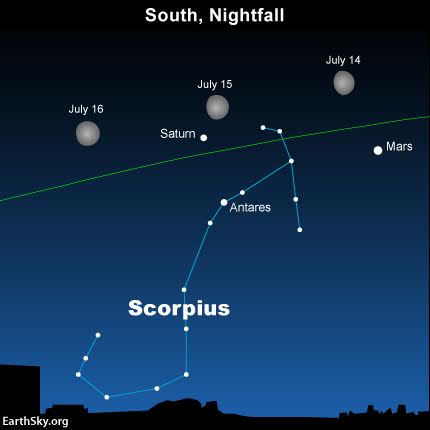
Watch for the moon to swing close to Mars on July 14 and then Saturn on July 15. Read more.
Mars, dusk until after midnight, shines near Saturn. Mars is still wonderfully bright this month, though fainter than it was in June 2016!
Mars was at its brightest at its opposition on May 22. Jupiter was at its brightest during its opposition on March 8. Mars and Jupiter will remain spectacularly bright in the July night sky, but, by the month’s end, you’ll notice the brightness of Mars has waned somewhat.
Looking for a sky almanac? EarthSky recommends…
Here’s some really good news, though. Mars is near another planet on the sky’s dome, Saturn. Look for Mars and Saturn near Antares, the brightest star in the constellation Scorpius the Scorpion. They make a noticeable triangle on the sky’s dome.
Let the moon help guide your eye to Mars (plus Saturn and the bright star Antares) for several evenings, centered on or near July 14. Then watch for the moon to move away from Mars and to sail by Saturn on July 15.
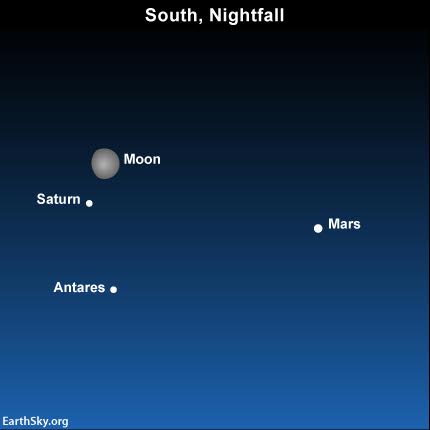
The moon swings close to the ringed planet Saturn on July 15. Read more.
Saturn, dusk until after midnight, shines near Mars. Both Mars and Saturn are near a fainter object – still one of the sky’s brightest stars – Antares in the constellation Scorpius.
The ringed planet starts out the month appearing in the south to southeast sky at nightfall. At the beginning of the month, Saturn will soar to its highest point for the night around 10 p.m. local time (11 p.m. local Daylight Saving Time). By the month’s end, Saturn will be at its high point around 8 p.m. local time (9 p.m. local Daylight Saving Time).
Although Saturn shines on par with the sky’s brightest stars, its brilliance can’t match that of Mars. Look for Saturn near Mars all month long. These two worlds form a bright celestial triangle with the star Antares in the July night sky. Mars is brighter than Saturn, which in turn is brighter than Antares.
Mars will eventually catch up with Saturn on August 24, 2016, to present a conjunction of these two worlds in the August evening sky.
Watch for the moon to swing by Saturn for several days, centered on or near July 15.
Saturn, the farthest world that you can easily view with the eye alone, appears golden in color. It shines with a steady light. Binoculars don’t reveal Saturn’s gorgeous rings, by the way. For that, you need a small telescope. But binoculars will enhance Saturn’s golden color.
Saturn’s rings are inclined at a little more than 26o from edge-on in July 2016, exhibiting their northern face. Next year, in October 2017, the rings will open most widely, displaying a maximum inclination of 27o.
As with so much in space (and on Earth), the appearance of Saturn’s rings from Earth is cyclical. In the year 2025, the rings will appear edge-on as seen from Earth. After that, we’ll begin to see the south side of Saturn’s rings, to increase to a maximum inclination of 27o by May 2032.
Click here for recommended almanacs. They can help you know when the planets rise, transit and set in your sky

For a big sky watching challenge, try finding the planet Mercury in conjunction with the star Regulus on July 30, 2016. Mercury and Regulus will be in between the dazzling planets Venus and Jupiter, the third and fourth brightest celestial bodies, respectively, after the sun and moon. Read more.
Mercury, innermost planet, low in west after sunset. Mercury transitions from the morning to evening sky on July 7, 2016. Your first chance to view Mercury after sunset will probably come on or around July 16, when Venus and Mercury are in conjunction. You might see Venus with the unaided eye, but you’ll probably need binoculars to glimpse Mercury.
Throughout the month, Mercury will climb higher up at sunset and set later after sundown. Mercury may not become visible to the naked eye until late July or early August. For another big challenge, try viewing Mercury snuggling up with the star Regulus in the western dusk on July 30.
Click here for an almanac giving Mercury’s setting time into your sky.

It’s a long shot, perhaps, by why not try to catch the young moon and Venus after sunset on July 5, 6 and 7? Read more.
Venus, brightest planet, low in west after sunset. Venus swung directly behind the sun on June 6, 2016, to transition from the morning to the evening sky. Exactly four years previous to Venus passing directly behind the sun on June 6, 2016, Venus swung directly in front of the sun on June 6, 2012, to present the last transit of Venus until December 11, 2117. See the photo below.
Venus might become visible in the western sky after to the unaided eye at dusk by around mid-July. If you’re an eagle-eyed observer, try catching the young moon and Venus after sunset on July 5. If you miss the coupling of the moon and Venus on July 5, you’ll have another chance to catch Venus in conjunction with Mercury on July 16. Undoubtedly, an optical aid will come in handy on both dates!
Venus will become easier to see in the western evening twilight in August, and even more so in September.
What do we mean by bright planet? By bright planet, we mean any solar system planet that is easily visible without an optical aid and that has been watched by our ancestors since time immemorial. In their outward order from the sun, the five bright planets are Mercury, Venus, Mars, Jupiter and Saturn. These planets actually do appear bright in our sky. They are typically as bright as – or brighter than – the brightest stars. Plus, these relatively nearby worlds tend to shine with a steadier light than the distant, twinkling stars. You can spot them, and come to know them as faithful friends, if you try.
Bottom line: In July 2016, Jupiter is the brightest starlike object up when the sun goes down (unless you happen to glimpse Venus low in the west after sunset). Saturn and the bright star Antares make a triangle with Mars on the sky’s dome. Mercury, the innermost planet, is returning to the evening sky, to .
Easily locate stars and constellations with EarthSky’s planisphere.
Don’t miss anything. Subscribe to EarthSky News by email
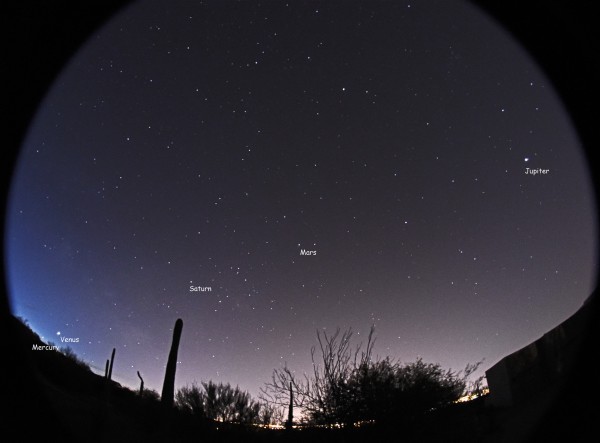
From late January, and through mid-February, 5 bright planets were visible at once in the predawn sky. This image is from February 8, 2016. It’s by Eliot Herman in Tucson, Arizona. View on Flickr.
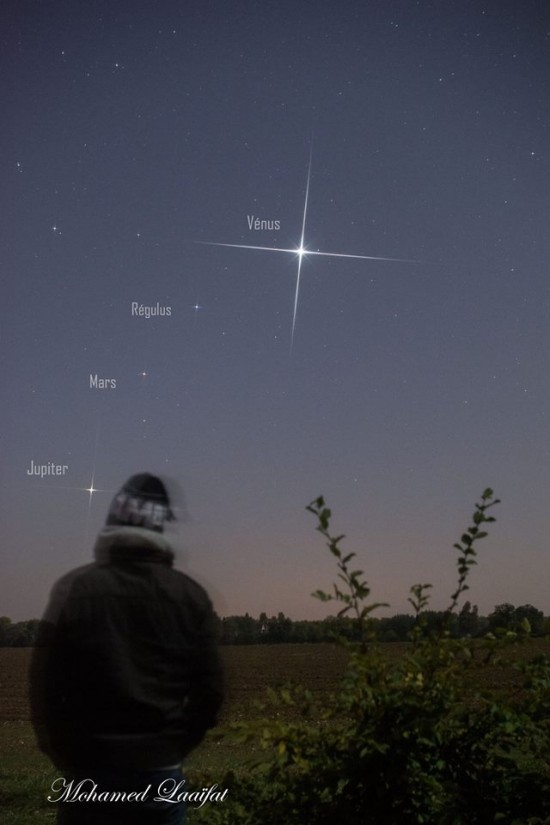
Awesome month for planets before dawn: October, 2015! Photo taken October 2, 2015 by Mohamed Laaifat Photographies in Normandy, France.
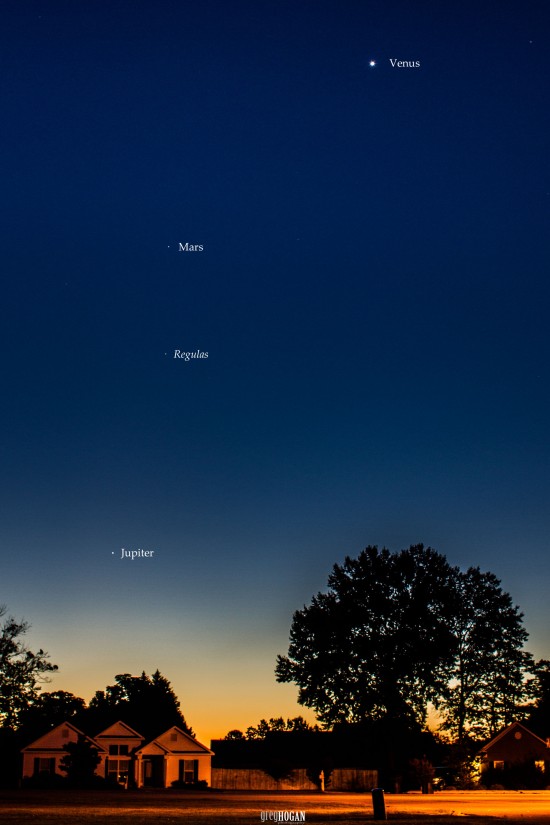
Eastern sky before dawn now. Photo taken September 18, 2015 and submitted to EarthSky by Greg Hogan in Kathleen, Georgia. Thanks, Greg!
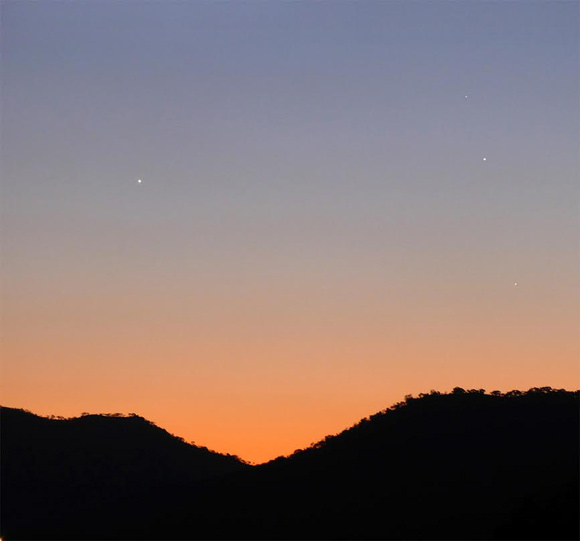
View larger. Evening dusk on August 5: Venus at left. Mercury is climbing higher, toward Regulus (at top) and Jupiter (beneath Regulus).

By the evening of July 12, Venus and Jupiter were farther apart and lower in the western sky after sunset. Photo by Robert Kelly. Thanks, Robert!
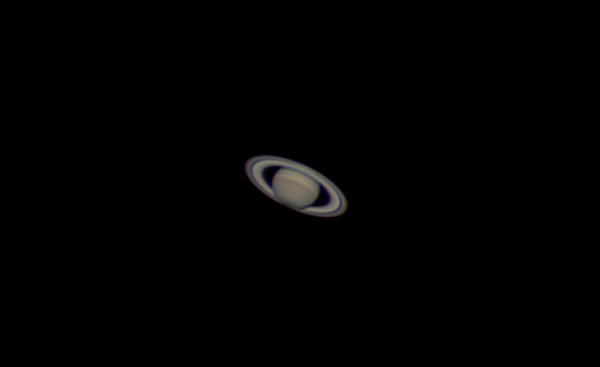
Photo taken June 13, 2015 by John Nelson at Puget Sound, Washington. Thanks, John!
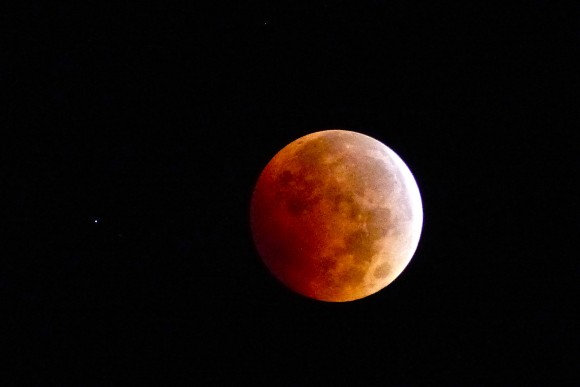
Lunar eclipse on the night of October 8, 2014. The object to the left is the planet Uranus! This beautiful photo is by Janey Wing Kenyon of Story, Wyoming.
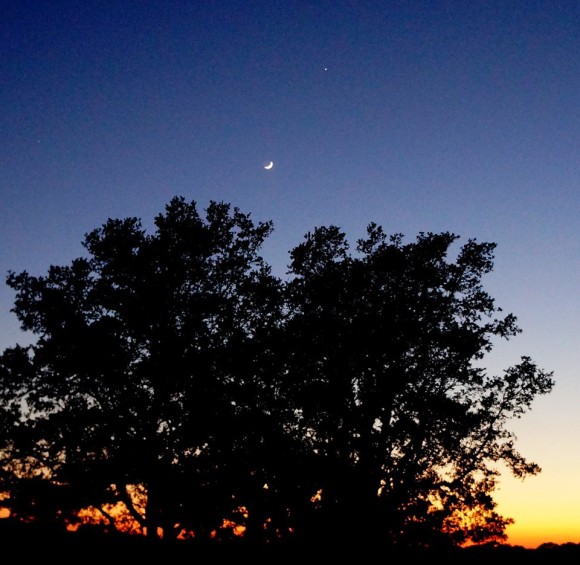
Debra Fryar in Calobreves, Texas captured this photo of the moon and Jupiter on May 31, 2014. Jupiter was close to the twilight then.
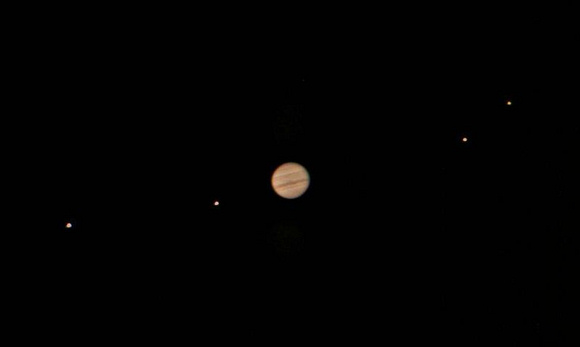
With only a modest backyard telescope, you can easily see Jupiter’s four largest moons. Here they are through a 10″ (25 cm) Meade LX200 telescope. Image credit: Jan Sandberg
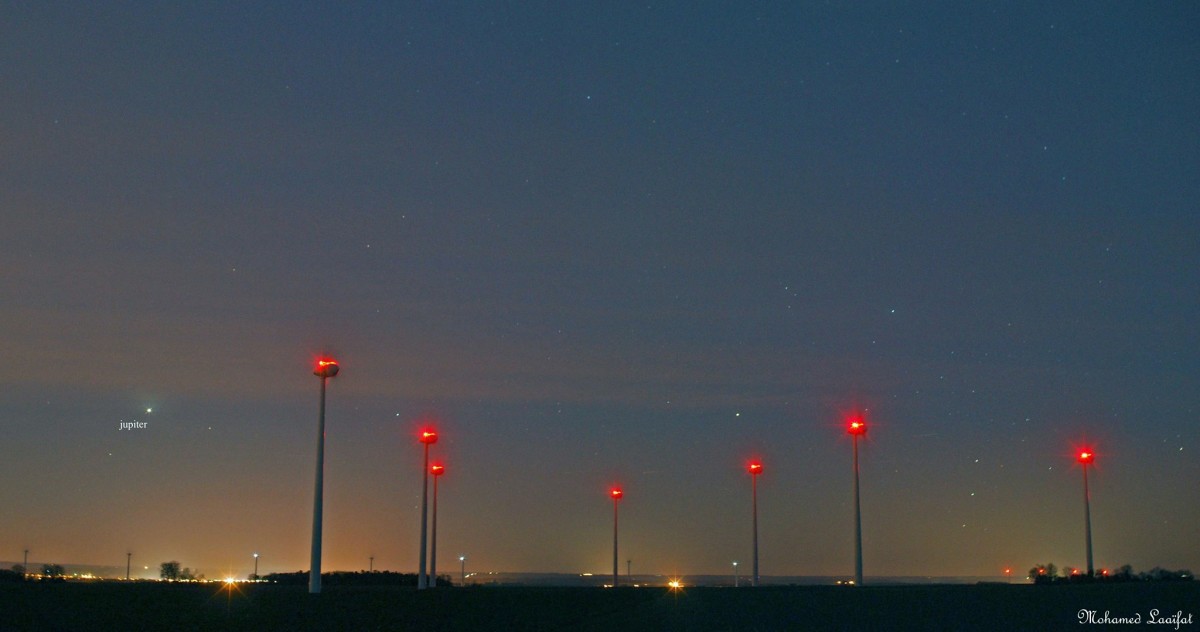
Jupiter was rivaling the streetlights, when Mohamed Laaifat Photographies captured this photo in Normandy, France. Visit his page on Facebook.

Venus by Danny Crocker-Jensen
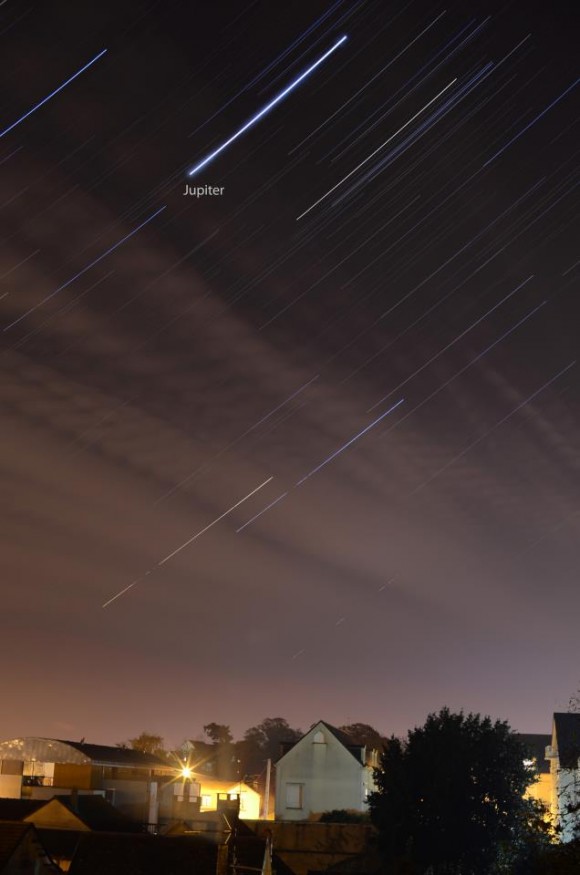
These are called star trails. It’s a long-exposure photo, which shows you how Earth is turning under the stars. The brightest object here is Jupiter, which is the second-brightest planet, after Venus. This awesome photo by EarthSky Facebook friend Mohamed Laaifat in Normandy, France. Thank you, Mohamed.
Easily locate stars and constellations with EarthSky’s planisphere.
Don’t miss anything. Subscribe to EarthSky News by email
from EarthSky http://ift.tt/IJfHCr


Skywatcher, by Predrag Agatonovic.
Three planets – Jupiter, Mars and Saturn – pop out as darkness falls in June 2016. Jupiter, the brightest of the bunch, is found in the western half of the sky and lights up the night until midnight or later. Mars, only a touch fainter than Jupiter, shines above Saturn in the southeast sky at nightfall. Saturn comes closest to Earth for the year on June 3, less than four days after Mars’ closest approach to Earth on May 30. Mars and Saturn shine close to the supergiant red star Antares on the sky’s dome, painting a bright and colorful triangle on the blackboard of night. Not only are Mars and Saturn at their brightest and best in late May and early June, they’re out all night long. Mercury appears as a morning “star” before sunrise, though this morning showing of Mercury greatly favors the Southern Hemisphere. The brightest planet – Venus – is lost in the glare of sun in June. Follow the links below to learn more about the June planets.
Jupiter brightest “star” in June
Mars, dusk until dawn, shines near Saturn
Saturn, dusk until dawn, shines near Mars
Mercury in eastern predawn sky
Venus, brightest planet, lost in the sunrise
Like what EarthSky offers? Sign up for our free daily newsletter today!
Astronomy events, star parties, festivals, workshops

Three planets – Jupiter, Mars and Saturn – are bright in the evening sky throughout June 2016!

Use the moon to find planet Jupiter, star Regulus and constellation Leo on the evenings of June 9, June 10 and June 11. The green line depicts the ecliptic – the sun and moon’s pathway in front of the constellations of the zodiac.
Jupiter brightest “star” in June. Jupiter lights up the sky almost immediately after sunset on these June evenings. From mid-northern latitudes, the king planet shines in the southwest sky at nightfall. From the Southern Hemisphere, look in the northern sky as darkness falls.
For all of us, Jupiter sets in the west at or around midnight. It will remain a fine evening object throughout July and into August.
Jupiter is almost impossible to miss. It’s the fourth-brightest celestial object, after the sun, moon and Venus. But Venus is now lost in the glare of the sun, so Jupiter rules the nighttime on June evenings. Although Mars is not all that much fainter than Jupiter in early June, Jupiter and Mars are nowhere close together on the sky’s dome. As evening falls, Mars and Saturn sit rather low in the southeast sky, while Jupiter appears in the western half of sky. Most of all, Mars’ bloody-red color is dead giveaway of the red planet. Jupiter, on the other hand, shines bold white.
The moon swings close to Jupiter on the sky’s dome on June 10 and June 11.
If you have binoculars (on a tripod) or a telescope, it’s fairly easy to see Jupiter’s four major moons, which look like pinpricks of light on or near the same plane. They are often called the Galilean moons to honor Galileo, who discovered these great Jovian moons in 1610. In their order from Jupiter, these moons are Io, Europa, Ganymede and Callisto.

View larger. Jupiter and the Galilean moons through a 10″ (25 cm) Meade LX200 telescope via Jan Sandberg.
These moons circle Jupiter around the Jovian equator. In cycles of six years, we view Jupiter’s equator edge-on. So, in 2015, we got to view a number of mutual events involving Jupiter’s moons through a high-powered telescope. Click here or here or here for more details.
Although Jupiter’s axial tilt is only 3o out of perpendicular relative to the ecliptic (Earth’s orbital plane), Jupiter’s axis will tilt enough toward the sun and Earth so that the farthest of these four moons, Callisto, will not pass in front of Jupiter or behind Jupiter for a period of about three years, starting in late 2016.
During this approximate 3-year period, Callisto will remain perpetually visible, alternately swinging above and below Jupiter from our earthly perspective.
Click here for a Jupiter moons almanac, courtesy of Sky & Telescope.

View larger | Mikhail Chubarets in the Ukraine made this chart. It shows the view of Mars through a telescope in 2016. We pass between Mars and the sun on May 22. We won’t see Mars as a disk like this with the eye alone. But, between the start of 2016 and May, the dot of light that is Mars grows dramatically brighter and redder in our night sky. Watch for it!

Watch the brilliant waxing gibbous moon swing by the planets Mars and Saturn, plus the star Antares, on June 16, June 17 and June 18.
Mars, dusk until dawn, shines near Saturn. Mars is almost as bright as Jupiter when the month begins, but will fade quickly this month!
Mars was at its brightest at its opposition on May 22. Jupiter was at its brightest during its opposition on March 8. Mars and Jupiter will remain spectacularly bright in the June night sky, but, by the month’s end, you’ll notice the edge has gone off Mars’ brightness.
Looking for a sky almanac? EarthSky recommends…
Here’s some really good news, though. Mars is near another planet on the sky’s dome, Saturn. Look for Mars and Saturn near Antares, the brightest star in the constellation Scorpius the Scorpion. They make a noticeable triangle on the sky’s dome.
Let the moon help guide your eye to Mars (and the bright star Spica) for several evenings, centered on June 15. Then watch for the moon to swing away from Spica and more closely with Mars on June 16 and June 17. Then by June 18, the moon will move away from Mars to pair up with Saturn.

Yes, you can find the ringed Saturn near the brighter red planet Mars throughout June 2016! You can also find the bright star Spica between Jupiter and Mars. The green line depicts the ecliptic – pathway of the sun, moon and planets in front of the constellations of the zodiac. Read more.
Saturn, dusk until dawn, shines near Mars. Both Mars and Saturn are near a fainter object – still one of the sky’s brightest stars – Antares in the constellation Scorpius.
The ringed planet starts the month rising in the east around sunset. That’s because Saturn will be at opposition – opposite the sun in Earth’s sky – on June 3. At opposition, Saturn is rising in the east at sunset, and setting in the west at sunrise. At midnight, meanwhile, Saturn is highest up for the night. By the month’s end, Saturn will be coming up in the east roughly two hours before sunset, and will soar to its highest point for the night around 10 p.m. local time (11 p.m. local Daylight Saving Time).
Although Saturn shines on par with the sky’s brightest stars, its brilliance can’t match that of Mars. Look for Saturn near Mars all month long. These two worlds form a bright celestial triangle with the star Antares in the June night sky. Mars is brighter than Saturn, which in turn is brighter than Antares.
Mars will eventually catch up with Saturn on August 24, 2016, to present a conjunction of these two worlds in the August evening sky.
Watch for the moon to swing by Saturn for several days, centered on or near June 18.
Saturn, the farthest world that you can easily view with the eye alone, appears golden in color. It shines with a steady light. Binoculars don’t reveal Saturn’s gorgeous rings, by the way. For that, you need a small telescope. But binoculars will enhance Saturn’s golden color.
Saturn’s rings are inclined at a little more than 26o from edge-on in June 2016, exhibiting their northern face. Next year, in October 2017, the rings will open most widely, displaying a maximum inclination of 27o.
As with so much in space (and on Earth), the appearance of Saturn’s rings from Earth is cyclical. In the year 2025, the rings will appear edge-on as seen from Earth. After that, we’ll begin to see the south side of Saturn’s rings, to increase to a maximum inclination of 27o by May 2032.
Click here for recommended almanacs. They can help you know when the planets rise, transit and set in your sky

The slender waning crescent moon and Mercury, from the perspective of middle latitudes in the Northern Hemisphere. The Southern Hemisphere enjoys a much better view of Mercury in the morning sky because Mercury rises before morning dawn in that part of the world.
Mercury in eastern predawn sky. Mercury transitioned from the evening to morning sky on May 9, 2016. Usually, you can’t see Mercury at this juncture because it swings to the north or south of the solar disk, and is lost in the sun’s glare. But this time around, some of you actually witnessed the planet Mercury passing directly in front of the sun on June 3, less than four days after Mars’ closest approach to Earth on May 30. Mars and Saturn shine close to the supergiant red star Antares on the sky’s dome, painting a bright and colorful triangle on the blackboard of night. Although Mars and Saturn won’t be at their brightest and best in July, they’re still plenty bright and easy to see – especially Mars! Mercury and Venus sit low in the glare of evening twilight and follow the sun below the horizon before nightfall. In other words, these two worlds – but especially Mercury – are hard to spot after sunset in July 2016! Follow the links below to learn more about the July planets.
Jupiter brightest “star” on July evenings
Mars, dusk until after midnight, shines near Saturn
Saturn, dusk until after midnight, shines near Mars
Mercury, innermost planet, low in west after sunset
Venus, brightest planet, low in west after sunset
Like what EarthSky offers? Sign up for our free daily newsletter today!
Astronomy events, star parties, festivals, workshops

Watch for the waxing crescent moon to be close to the dazzling planet Jupiter for several days, centered on or near July 8. Read more.
Jupiter brightest “star” on July evenings. Jupiter lights up the sky almost immediately after sunset on these July evenings. From mid-northern latitudes, the king planet shines in the southwest sky at nightfall. From the Southern Hemisphere, look in the north to northwest sky as darkness falls.
For all of us, Jupiter sets in the west at late evening in the beginning of the month and early evening by the month’s end. It will start to fade into the sunset by late August.
Jupiter is almost impossible to miss. It’s the fourth-brightest celestial object, after the sun, moon and Venus. But Venus is now lost – or nearly lost – in the glare of the sun, so Jupiter rules the nighttime on July evenings. As evening falls, Mars and Saturn shine in the southern sky, while Jupiter appears in the west. So it should be pretty easy to distinguish Jupiter from ruddy Mars, especially since these two brilliant worlds shine in different parts of the sky.
The moon swings close to Jupiter on the sky’s dome for several days, centered on or near July 8.
If you have binoculars (on a tripod) or a telescope, it’s fairly easy to see Jupiter’s four major moons, which look like pinpricks of light on or near the same plane. They are often called the Galilean moons to honor Galileo, who discovered these great Jovian moons in 1610. In their order from Jupiter, these moons are Io, Europa, Ganymede and Callisto.

View larger. Jupiter and the Galilean moons through a 10″ (25 cm) Meade LX200 telescope via Jan Sandberg.
These moons circle Jupiter around the Jovian equator. In cycles of six years, we view Jupiter’s equator edge-on. So, in 2015, we got to view a number of mutual events involving Jupiter’s moons through a high-powered telescope. Click here for more details.
Although Jupiter’s axial tilt is only 3o out of perpendicular relative to the ecliptic (Earth’s orbital plane), Jupiter’s axis will tilt enough toward the sun and Earth so that the farthest of these four moons, Callisto, will not pass in front of Jupiter or behind Jupiter for a period of about three years, starting in late 2016.
During this approximate 3-year period, Callisto will remain perpetually visible, alternately swinging above and below Jupiter from our earthly perspective.
Click here for a Jupiter moons almanac, courtesy of Sky & Telescope.

View larger | Mikhail Chubarets in the Ukraine made this chart. It shows the view of Mars through a telescope in 2016. We pass between Mars and the sun on May 22. We won’t see Mars as a disk like this with the eye alone. But, between the start of 2016 and May, the dot of light that is Mars grows dramatically brighter and redder in our night sky. Watch for it!

Watch for the moon to swing close to Mars on July 14 and then Saturn on July 15. Read more.
Mars, dusk until after midnight, shines near Saturn. Mars is still wonderfully bright this month, though fainter than it was in June 2016!
Mars was at its brightest at its opposition on May 22. Jupiter was at its brightest during its opposition on March 8. Mars and Jupiter will remain spectacularly bright in the July night sky, but, by the month’s end, you’ll notice the brightness of Mars has waned somewhat.
Looking for a sky almanac? EarthSky recommends…
Here’s some really good news, though. Mars is near another planet on the sky’s dome, Saturn. Look for Mars and Saturn near Antares, the brightest star in the constellation Scorpius the Scorpion. They make a noticeable triangle on the sky’s dome.
Let the moon help guide your eye to Mars (plus Saturn and the bright star Antares) for several evenings, centered on or near July 14. Then watch for the moon to move away from Mars and to sail by Saturn on July 15.

The moon swings close to the ringed planet Saturn on July 15. Read more.
Saturn, dusk until after midnight, shines near Mars. Both Mars and Saturn are near a fainter object – still one of the sky’s brightest stars – Antares in the constellation Scorpius.
The ringed planet starts out the month appearing in the south to southeast sky at nightfall. At the beginning of the month, Saturn will soar to its highest point for the night around 10 p.m. local time (11 p.m. local Daylight Saving Time). By the month’s end, Saturn will be at its high point around 8 p.m. local time (9 p.m. local Daylight Saving Time).
Although Saturn shines on par with the sky’s brightest stars, its brilliance can’t match that of Mars. Look for Saturn near Mars all month long. These two worlds form a bright celestial triangle with the star Antares in the July night sky. Mars is brighter than Saturn, which in turn is brighter than Antares.
Mars will eventually catch up with Saturn on August 24, 2016, to present a conjunction of these two worlds in the August evening sky.
Watch for the moon to swing by Saturn for several days, centered on or near July 15.
Saturn, the farthest world that you can easily view with the eye alone, appears golden in color. It shines with a steady light. Binoculars don’t reveal Saturn’s gorgeous rings, by the way. For that, you need a small telescope. But binoculars will enhance Saturn’s golden color.
Saturn’s rings are inclined at a little more than 26o from edge-on in July 2016, exhibiting their northern face. Next year, in October 2017, the rings will open most widely, displaying a maximum inclination of 27o.
As with so much in space (and on Earth), the appearance of Saturn’s rings from Earth is cyclical. In the year 2025, the rings will appear edge-on as seen from Earth. After that, we’ll begin to see the south side of Saturn’s rings, to increase to a maximum inclination of 27o by May 2032.
Click here for recommended almanacs. They can help you know when the planets rise, transit and set in your sky

For a big sky watching challenge, try finding the planet Mercury in conjunction with the star Regulus on July 30, 2016. Mercury and Regulus will be in between the dazzling planets Venus and Jupiter, the third and fourth brightest celestial bodies, respectively, after the sun and moon. Read more.
Mercury, innermost planet, low in west after sunset. Mercury transitions from the morning to evening sky on July 7, 2016. Your first chance to view Mercury after sunset will probably come on or around July 16, when Venus and Mercury are in conjunction. You might see Venus with the unaided eye, but you’ll probably need binoculars to glimpse Mercury.
Throughout the month, Mercury will climb higher up at sunset and set later after sundown. Mercury may not become visible to the naked eye until late July or early August. For another big challenge, try viewing Mercury snuggling up with the star Regulus in the western dusk on July 30.
Click here for an almanac giving Mercury’s setting time into your sky.

It’s a long shot, perhaps, by why not try to catch the young moon and Venus after sunset on July 5, 6 and 7? Read more.
Venus, brightest planet, low in west after sunset. Venus swung directly behind the sun on June 6, 2016, to transition from the morning to the evening sky. Exactly four years previous to Venus passing directly behind the sun on June 6, 2016, Venus swung directly in front of the sun on June 6, 2012, to present the last transit of Venus until December 11, 2117. See the photo below.
Venus might become visible in the western sky after to the unaided eye at dusk by around mid-July. If you’re an eagle-eyed observer, try catching the young moon and Venus after sunset on July 5. If you miss the coupling of the moon and Venus on July 5, you’ll have another chance to catch Venus in conjunction with Mercury on July 16. Undoubtedly, an optical aid will come in handy on both dates!
Venus will become easier to see in the western evening twilight in August, and even more so in September.
What do we mean by bright planet? By bright planet, we mean any solar system planet that is easily visible without an optical aid and that has been watched by our ancestors since time immemorial. In their outward order from the sun, the five bright planets are Mercury, Venus, Mars, Jupiter and Saturn. These planets actually do appear bright in our sky. They are typically as bright as – or brighter than – the brightest stars. Plus, these relatively nearby worlds tend to shine with a steadier light than the distant, twinkling stars. You can spot them, and come to know them as faithful friends, if you try.
Bottom line: In July 2016, Jupiter is the brightest starlike object up when the sun goes down (unless you happen to glimpse Venus low in the west after sunset). Saturn and the bright star Antares make a triangle with Mars on the sky’s dome. Mercury, the innermost planet, is returning to the evening sky, to .
Easily locate stars and constellations with EarthSky’s planisphere.
Don’t miss anything. Subscribe to EarthSky News by email

From late January, and through mid-February, 5 bright planets were visible at once in the predawn sky. This image is from February 8, 2016. It’s by Eliot Herman in Tucson, Arizona. View on Flickr.

Awesome month for planets before dawn: October, 2015! Photo taken October 2, 2015 by Mohamed Laaifat Photographies in Normandy, France.

Eastern sky before dawn now. Photo taken September 18, 2015 and submitted to EarthSky by Greg Hogan in Kathleen, Georgia. Thanks, Greg!

View larger. Evening dusk on August 5: Venus at left. Mercury is climbing higher, toward Regulus (at top) and Jupiter (beneath Regulus).

By the evening of July 12, Venus and Jupiter were farther apart and lower in the western sky after sunset. Photo by Robert Kelly. Thanks, Robert!

Photo taken June 13, 2015 by John Nelson at Puget Sound, Washington. Thanks, John!

Lunar eclipse on the night of October 8, 2014. The object to the left is the planet Uranus! This beautiful photo is by Janey Wing Kenyon of Story, Wyoming.

Debra Fryar in Calobreves, Texas captured this photo of the moon and Jupiter on May 31, 2014. Jupiter was close to the twilight then.

With only a modest backyard telescope, you can easily see Jupiter’s four largest moons. Here they are through a 10″ (25 cm) Meade LX200 telescope. Image credit: Jan Sandberg

Jupiter was rivaling the streetlights, when Mohamed Laaifat Photographies captured this photo in Normandy, France. Visit his page on Facebook.

Venus by Danny Crocker-Jensen

These are called star trails. It’s a long-exposure photo, which shows you how Earth is turning under the stars. The brightest object here is Jupiter, which is the second-brightest planet, after Venus. This awesome photo by EarthSky Facebook friend Mohamed Laaifat in Normandy, France. Thank you, Mohamed.
Easily locate stars and constellations with EarthSky’s planisphere.
Don’t miss anything. Subscribe to EarthSky News by email
from EarthSky http://ift.tt/IJfHCr
